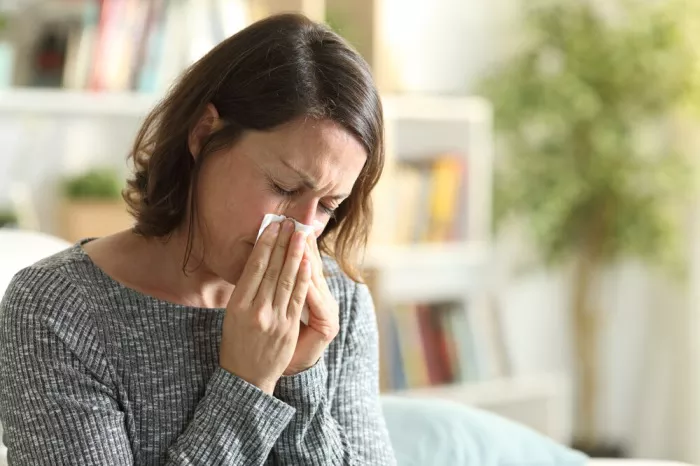Allergic rhinitis is a common but often underestimated medical condition that affects millions of people worldwide. Also known as hay fever, allergic rhinitis is an allergic reaction that occurs when the immune system overreacts to allergens in the environment. In this article, we will delve deep into the intricacies of allergic rhinitis, exploring its causes, symptoms, diagnosis, treatment options, and how it impacts the lives of those who suffer from it. By the end of this comprehensive discussion, you will have a thorough understanding of allergic rhinitis and its far-reaching effects on individuals and society as a whole.
What is Allergic Rhinitis?
Allergic rhinitis, commonly referred to as hay fever, is an allergic response characterized by inflammation of the nasal passages. The condition occurs when the immune system reacts excessively to allergens, substances that are otherwise harmless to most people. These allergens can be found in various forms, such as pollen, dust mites, pet dander, and mold spores. When a person with allergic rhinitis comes into contact with these allergens, their immune system releases chemicals, including histamines, which trigger symptoms like sneezing, runny nose, itching, and congestion.
The Prevalence of Allergic Rhinitis
Allergic rhinitis is a widespread health issue, affecting a significant portion of the global population. According to the World Allergy Organization (WAO), approximately 10-30% of adults and 40% of children worldwide suffer from allergic rhinitis. These numbers highlight the substantial impact of this condition on public health.
Types of Allergic Rhinitis
Allergic rhinitis can be classified into two main types: seasonal and perennial.
Seasonal Allergic Rhinitis
Seasonal allergic rhinitis is often referred to as “hay fever” because it is most commonly triggered by outdoor allergens like pollen from trees, grasses, and weeds. Symptoms of seasonal allergic rhinitis typically occur during specific times of the year when these allergens are prevalent. Individuals with seasonal allergic rhinitis may experience worsened symptoms in the spring, summer, or fall, depending on their specific allergen triggers.
Perennial Allergic Rhinitis
Perennial allergic rhinitis differs from its seasonal counterpart in that it can occur year-round. This type of allergic rhinitis is usually triggered by indoor allergens such as dust mites, pet dander, mold spores, and cockroach droppings. Those with perennial allergic rhinitis often experience persistent symptoms regardless of the season.
Causes and Risk Factors of Allergic Rhinitis
Understanding the causes and risk factors associated with allergic rhinitis is essential for effective management and prevention.
Allergen Exposure
The primary cause of allergic rhinitis is exposure to allergens. When individuals with a genetic predisposition come into contact with allergens like pollen, dust mites, or pet dander, their immune system responds by releasing histamines and other chemicals. This immune response leads to the characteristic symptoms of allergic rhinitis.
Genetic Predisposition
Genetics play a significant role in the development of allergic rhinitis. If one or both parents have allergies, their children are more likely to develop allergic rhinitis or other allergic conditions. However, the specific genes involved in this predisposition are complex and not fully understood.
Environmental Factors
Environmental factors, such as air pollution and exposure to tobacco smoke during early childhood, may increase the risk of developing allergic rhinitis. These factors can exacerbate symptoms and make the condition more severe in those who are already predisposed to it.
Hygiene Hypothesis
The hygiene hypothesis suggests that reduced exposure to infections in early childhood may increase the risk of allergic rhinitis and other allergic diseases. This theory posits that a lack of early exposure to microbes and infections weakens the immune system’s ability to distinguish between harmful and harmless substances, leading to an overactive response to allergens.
Symptoms of Allergic Rhinitis
Recognizing the symptoms of allergic rhinitis is crucial for early diagnosis and effective management. Common symptoms include:
Sneezing: Individuals with allergic rhinitis often experience frequent bouts of sneezing, especially after exposure to allergens.
Runny or Stuffy Nose: A runny or stuffy nose is a hallmark symptom of allergic rhinitis. The nasal passages become congested, and there may be clear nasal discharge.
Itching: Itchy eyes, nose, throat, and even ears are common in allergic rhinitis. This itching can be particularly bothersome and disruptive to daily life.
Watery Eyes: Allergic rhinitis can cause watery eyes, a condition known as allergic conjunctivitis. This can lead to redness and discomfort.
Coughing: A persistent cough may develop in some individuals with allergic rhinitis, as postnasal drip irritates the throat.
Fatigue: The chronic nature of allergic rhinitis, especially in perennial cases, can lead to fatigue and decreased energy levels due to disrupted sleep patterns.
Decreased Sense of Smell and Taste: Some people with allergic rhinitis may notice a reduced sense of smell and taste due to nasal congestion.
Dark Circles Under the Eyes: Known as allergic shiners, dark circles under the eyes can develop in response to chronic nasal congestion and poor sleep quality.
Diagnosing Allergic Rhinitis
Accurate diagnosis is essential for managing allergic rhinitis effectively. Healthcare providers use a combination of medical history, physical examination, and diagnostic tests to confirm the condition.
Medical History: A detailed medical history is crucial in identifying the presence of allergic rhinitis. Questions about the timing and duration of symptoms, allergen exposure, and family history of allergies can provide valuable information.
Physical Examination: A physical examination may reveal signs of allergic rhinitis, such as nasal congestion, a runny nose, or dark circles under the eyes. Doctors will also examine the throat and ears for any related symptoms.
Allergy Testing: Allergy testing can help pinpoint specific allergens that trigger allergic rhinitis. Two common types of allergy tests are skin prick tests and blood tests. Skin prick tests involve applying small amounts of allergens to the skin and monitoring for an allergic reaction, while blood tests measure the levels of specific antibodies related to allergies.
Treatment Options for Allergic Rhinitis
Managing allergic rhinitis involves a combination of allergen avoidance strategies and medical treatments. The choice of treatment depends on the severity of symptoms and the individual’s response to various interventions.
Allergen Avoidance
The first step in managing allergic rhinitis is to identify and minimize exposure to allergens. This may include:
Pollen Avoidance: For individuals with seasonal allergic rhinitis, staying indoors on high pollen days, keeping windows closed, and using air purifiers can help reduce pollen exposure.
Dust Mite Reduction: Those with perennial allergic rhinitis can benefit from measures like using allergen-proof mattress and pillow covers, washing bedding regularly in hot water, and vacuuming with a high-efficiency particulate air (HEPA) filter.
Pet Allergen Management: Pet owners may need to limit contact with allergenic animals, use air purifiers, and wash their pets regularly to reduce allergen levels.
Mold Control: Preventing moisture buildup and ensuring proper ventilation can help reduce mold spores in the indoor environment.
Pharmacological Treatment
Medications are commonly used to alleviate symptoms of allergic rhinitis. These include:
Antihistamines: Over-the-counter or prescription antihistamines can help relieve sneezing, itching, and a runny nose by blocking the effects of histamines.
Decongestants: Decongestants can reduce nasal congestion by narrowing blood vessels in the nasal passages. They are available in both oral and nasal spray forms.
Nasal Corticosteroids: These prescription medications reduce inflammation in the nasal passages, relieving congestion, sneezing, and runny nose. They are often considered first-line treatment for moderate to severe allergic rhinitis.
Leukotriene Modifiers: These medications help control allergic rhinitis symptoms by targeting specific immune system chemicals involved in the allergic response.
Immunotherapy: Allergy shots or sublingual tablets are an option for individuals with severe allergic rhinitis who do not respond well to other treatments. Immunotherapy involves gradually exposing the individual to increasing amounts of allergens to build tolerance.
Home Remedies and Lifestyle Changes
Alongside medical treatments, several home remedies and lifestyle changes can complement allergic rhinitis management:
Saline Nasal Irrigation: Rinsing the nasal passages with a saline solution can help reduce congestion and remove allergens.
Steam Inhalation: Inhaling steam from a bowl of hot water may provide temporary relief from nasal congestion.
Healthy Diet: Eating a balanced diet rich in fruits and vegetables can support overall immune health.
Regular Exercise: Engaging in regular physical activity can help boost immunity and reduce the severity of allergic rhinitis symptoms.
Stress Management: Reducing stress through techniques like meditation and deep breathing exercises may help alleviate symptoms.
The Impact of Allergic Rhinitis on Quality of Life
Allergic rhinitis is often perceived as a minor inconvenience, but its impact on an individual’s quality of life can be significant. The chronic nature of the condition, coupled with its bothersome symptoms, can lead to several challenges:
Sleep Disturbance: Nasal congestion and postnasal drip can disrupt sleep patterns, leading to fatigue and decreased cognitive function during the day.
Reduced Productivity: Allergic rhinitis can hinder an individual’s ability to focus and perform at work or school, leading to decreased productivity.
Social and Emotional Effects: Persistent symptoms can contribute to feelings of frustration, irritability, and social withdrawal. It can also lead to anxiety and depression in some individuals.
Financial Burden: The cost of medications, doctor visits, and missed work or school days due to allergic rhinitis can create a financial burden for individuals and families.
Exacerbation of Other Conditions: Allergic rhinitis can worsen other conditions such as asthma, leading to increased healthcare utilization and the need for additional treatments.
Preventing Allergic Rhinitis
While allergic rhinitis is often a result of genetic predisposition and environmental factors, there are steps individuals can take to reduce their risk or minimize the severity of symptoms:
Allergen Avoidance: As discussed earlier, minimizing exposure to known allergens can significantly reduce the risk of developing allergic rhinitis.
Early Allergy Management: Identifying and managing allergies in childhood, through strategies like breastfeeding and reducing exposure to tobacco smoke, may help reduce the risk of allergic rhinitis.
Immunotherapy: Allergy immunotherapy can be considered as a preventive measure in individuals at high risk of developing allergic rhinitis.
Conclusion
Allergic rhinitis, often referred to as hay fever, is a common allergic condition that affects millions of people worldwide. It can significantly impact an individual’s quality of life, causing bothersome symptoms and sometimes leading to complications like asthma. Understanding the causes, symptoms, diagnosis, and treatment options for allergic rhinitis is essential for effective management and prevention. By implementing allergen avoidance strategies, seeking medical treatment when needed, and making lifestyle changes, individuals can better control their allergic rhinitis and enjoy a higher quality of life. As ongoing research continues to uncover new insights into this condition, we can hope for more advanced and tailored treatments in the future, ultimately improving the lives of those who suffer from allergic rhinitis.
In conclusion, allergic rhinitis is a prevalent condition with a significant impact on individuals and society, making it essential to raise awareness and support ongoing research and treatment efforts.
[inline_related_posts title=”You Might Be Interested In” title_align=”left” style=”list” number=”6″ align=”none” ids=”2515,2331,2328″ by=”categories” orderby=”rand” order=”DESC” hide_thumb=”no” thumb_right=”no” views=”no” date=”yes” grid_columns=”2″ post_type=”” tax=””]


































